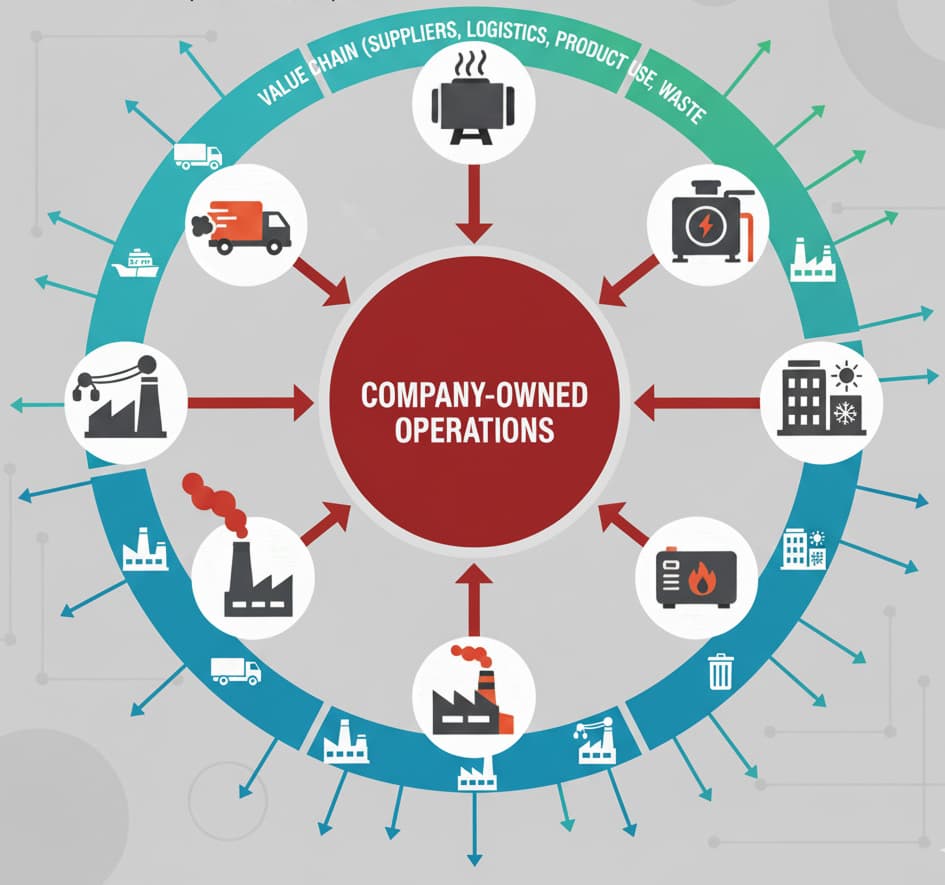Understanding Scope 3 Emissions: A Concise Guide

The Hidden Carbon Challenge
For most companies, the majority of their climate impact isn't in their offices or factories—it's hidden deep in their supply chains and in how customers use their products. These indirect emissions, known as Scope 3 emissions, can account for up to 90% of a company's total carbon footprint. Even renewable energy leaders face this challenge: a wind farm developer might run on 100% clean power, but what about the emissions from manufacturing turbine blades or the concrete in foundations?
What Are Scope 3 Emissions?
The Scope 3 emissions definition, according to the Greenhouse Gas Protocol, encompasses all indirect greenhouse gas (GHG) emissions occurring throughout a company's value chain—beyond what they directly control. While companies manage their Scope 1 emissions (direct emissions from owned sources) and can switch to renewable energy to address Scope 2 (purchased electricity), Scope 3 remains the most complex challenge.
The 15 Categories: Upstream and Downstream
Upstream (before production):
- Purchased goods and services
- Capital goods
- Fuel and energy-related activities
- Transportation and distribution
- Waste from operations
- Business travel
- Employee commuting
- Leased assets
Downstream (after production):
- Transportation and distribution
- Processing of sold products
- Use of sold products
- End-of-life treatment
- Leased assets
- Franchises
- Investments
Why Scope 3 Matters More Than Ever
Climate credibility depends on it. Companies claiming net-zero without addressing Scope 3 face increasing scrutiny and greenwashing accusations. Apple, for instance, has committed to carbon neutrality across its entire supply chain by 2030, while energy majors like Shell and BP include Scope 3 in their climate targets—though implementation remains controversial.
Regulatory pressure is mounting. The EU's Corporate Sustainability Reporting Directive (CSRD) and proposed SEC climate disclosure rules will require comprehensive value chain reporting. Companies that ignore Scope 3 today risk compliance failures tomorrow.
For the renewable energy sector specifically, Scope 3 presents unique challenges:
- Solar developers grapple with emissions from polysilicon production in coal-heavy grids
- Wind companies face steel and concrete emissions in turbine manufacturing
- Battery storage providers must account for lithium and cobalt mining impacts
- Financial institutions funding clean energy projects must report financed emissions
Reporting Requirements Under Science-Based Targets
The Science Based Targets initiative (SBTi) mandates that companies must include Scope 3 in their targets when these emissions exceed 40% of total emissions across all scopes. Key requirements:
- Coverage: At least 67% of Scope 3 emissions must be included in reduction targets
- Ambition: Targets must align with 1.5°C pathways
- Verification: Annual reporting through recognized frameworks
- Sector variance: Financial institutions and oil & gas companies face stricter requirements
Real-World Examples in Clean Energy
Solar Manufacturing
A solar panel manufacturer might achieve zero emissions in assembly facilities but face massive Scope 3 challenges from:
- Polysilicon production (often coal-powered in China)
- Aluminum framing and glass manufacturing
- International shipping and logistics
- End-of-life recycling or disposal
Wind Development
Offshore wind projects encounter Scope 3 emissions through:
- Steel production for towers and foundations (8% of global CO2)
- Rare earth mining for permanent magnets
- Vessel fuel for installation and maintenance
- Blade disposal challenges (currently mostly landfilled)
Energy Storage
Battery systems generate Scope 3 emissions via:
- Lithium, cobalt, and nickel extraction
- Cell manufacturing energy intensity
- Transportation across global supply chains
- Second-life applications and recycling
Innovative Solutions Emerging
Digital transformation accelerates measurement:
- Blockchain platforms verify supplier emissions data
- AI-powered tools estimate emissions from limited data
- Digital product passports track materials from source to disposal
Circular economy reduces emissions:
- Wind turbine blade recycling initiatives (Vestas' zero-waste goal)
- Battery second-life applications in stationary storage
- Solar panel recycling recovering 95% of semiconductor materials
Strategic procurement drives change:
- Renewable energy requirements for suppliers
- Local sourcing to reduce transportation emissions
- Investment in supplier decarbonization programs
Taking Action: Your Scope 3 Roadmap
Start by mapping your complete value chain to identify emission hotspots—typically 3-5 categories dominate
Measure using spend-based methods initially, then transition to supplier-specific data
Set science-aligned targets that contribute to net-zero pathways and prepare for regulatory requirements
Engage suppliers through capacity building, not just mandates—help them access renewable energy
Invest in innovation including low-carbon materials, circular design, and clean logistics
Report transparently using recognized frameworks (GHG Protocol, CDP, TCFD) to build stakeholder trust
The Path Forward
As renewable energy scales globally, addressing Scope 3 emissions becomes critical for authentic climate leadership. Companies that master their value chain emissions today will lead tomorrow's truly sustainable economy. The question isn't whether to tackle Scope 3, but how quickly you can transform your entire value chain.
Clean power purchase agreements might eliminate your Scope 2, but the real climate impact—and opportunity—lies in the scope 3 ghg emissions throughout your value chain. The energy transition demands we look beyond our own operations to the full lifecycle of our products and services.
